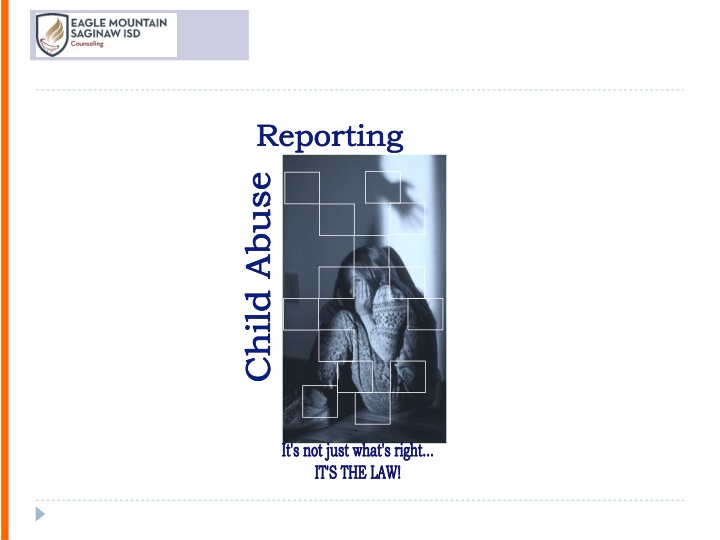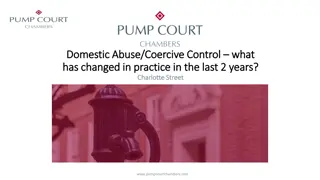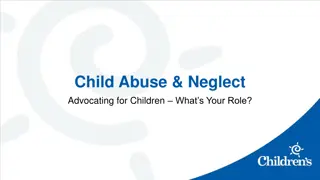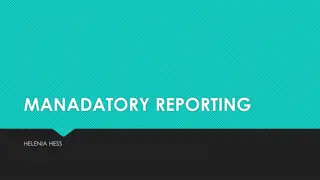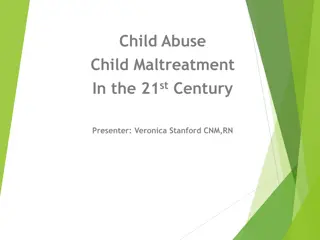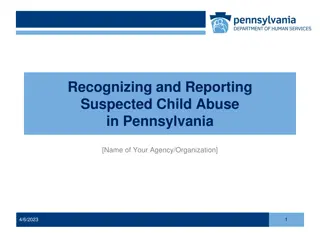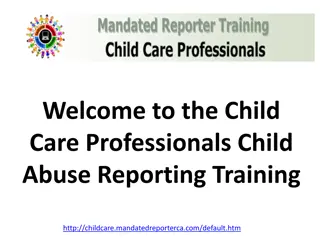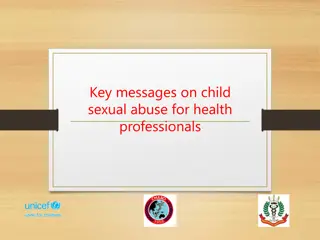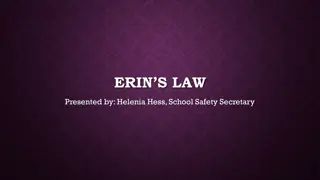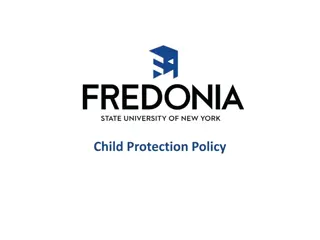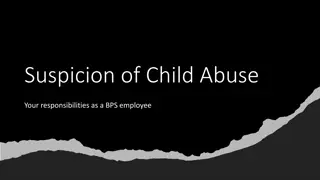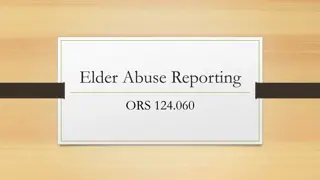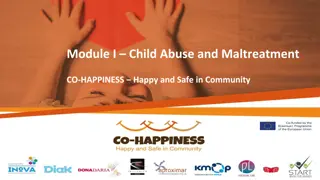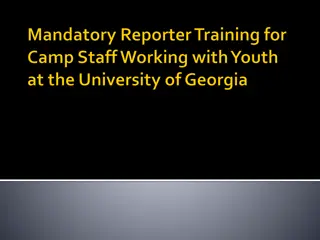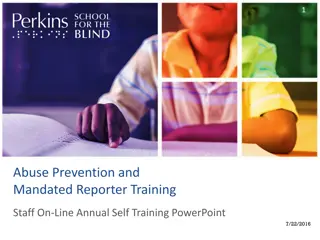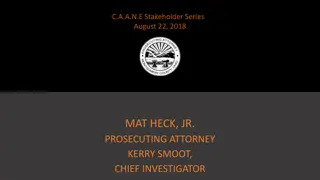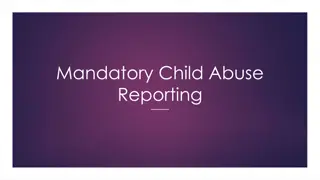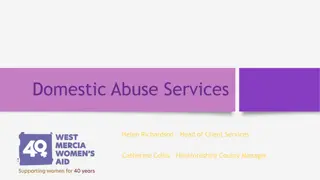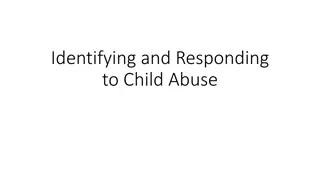Recognizing and Reporting Child Abuse: What You Need to Know
Understanding the signs of child abuse and neglect is crucial for protecting children. Learn about the laws requiring reporting, the different types of abuse, warning signs, and what you can do to help prevent child maltreatment. Remember, reporting suspicions of abuse is not just a moral duty but a legal obligation that can make a significant difference in a child's life.
Uploaded on Sep 08, 2024 | 3 Views
Download Presentation

Please find below an Image/Link to download the presentation.
The content on the website is provided AS IS for your information and personal use only. It may not be sold, licensed, or shared on other websites without obtaining consent from the author.If you encounter any issues during the download, it is possible that the publisher has removed the file from their server.
You are allowed to download the files provided on this website for personal or commercial use, subject to the condition that they are used lawfully. All files are the property of their respective owners.
The content on the website is provided AS IS for your information and personal use only. It may not be sold, licensed, or shared on other websites without obtaining consent from the author.
E N D
Presentation Transcript
Reporting Child Abuse It's not just what's right...
Child Abuse and Neglect What the Law Requires Warning Signs of Abuse Warning Signs of Neglect Reporting Procedures
Child Abuse and Neglect Report of Suspected Child Abuse/Neglect TX Statue 261.101 requires a person having cause to believe that a child s physical, mental health or welfare has been adversely affected by abuse or neglect by any person to immediately make a report. The person shall make a report no later than the 48th hour the professional first suspects the child has been or may be abused or neglected. A professional may not delegate to or rely on another person to make the report for them. TX Statue 261.109 declares a person commits an offense if the person has cause to believe that a child s physical, mental health, or welfare has been or may be adversely affected by abuse or neglect and knowingly fails to make a report. An offense under this section is a Class B misdemeanor and is punishable by a fine of up to $2,000, 180 days in jail, or both.
Child Abuse and Neglect Physical Abuse Physical abuse is a physical injury that results in substantial harm to the child, such as bruises, fractures, or death. It can also include a genuine threat of harm, even if there is no visible injury. Warning Signs Frequent injuries Burns or bruises in an unusual pattern Injuries that appear after child isn t seen for several days Frequent complaints of pain without obvious injury Fear of going home or seeing parent Frequent absences without reasonable explanation Wearing unseasonable clothes Lack of reaction to pain Reluctance to sit down Passive, withdrawn, and/or emotionless behavior Change in behavior
Child Abuse and Neglect Emotional Abuse Emotional abuse is an action that results in a marked impact on a child's growth, development, or psychological functioning. Emotional abuse includes extreme forms of punishment such as confining a child in a dark closet, habitual scapegoating, or belittling to the point that it results in noticeable effects on the child's daily functioning. Warning Signs Excessively withdrawn, fearful, or anxious about doing something wrong Shows extremes in behavior Doesn t seem to be attached to the parent or caregiver Acts either inappropriately adult or inappropriately infantile
Child Abuse and Neglect Sexual Abuse Sexual abuse is sexual conduct harmful to a child's mental, emotional, or physical welfare. This includes fondling a child s genitals, penetration, indecent exposure, and exploitation through prostitution or producing pornography. Warning Signs Difficulty in sitting or walking Physical signs of sexually transmitted disease(s) Physical signs of injury to the genital area Pregnancy in a young girl Extreme fear of being alone with adults, especially of a particular sex Sexually suggestive, inappropriate, or promiscuous behavior Knowledge about sexual relations that is not age appropriate Drawings/writings with strong or bizarre sexual themes Sexual victimization of other children
Child Abuse and Neglect Neglect There are various types of neglect including: Neglectful supervision Medical neglect Physical neglect Abandonment and refusal to accept parental responsibility Failure to protect a child Warning Signs Obvious malnutrition Torn and/or dirty clothes Lack of personal cleanliness Obvious fatigue and listlessness Begs for, or steals, food Unattended for long periods of time Needs glasses, dental care, or other medical attention Frequent absence or tardiness without reasonable explanation
Child Abuse and Neglect CPS Reporting Procedures Any person making a report to DFPS is immune from civil or criminal liability as long as the report is made in good faith. The reporter s name is confidential. Call the Texas abuse and neglect hotline at 1-800-252-5400. Non-emergency reports can be made online at www.txabusehotline.org. Be specific and provide as much information as possible, including demographic information. Document the date and time of the report and the case number. Follow up with a counselor and/or administrator any time you feel it would benefit the child.
Child Abuse and Neglect What Happens When a Report is Made? The Department of Family and Protective Services (DFPS) takes the information from the person reporting. They will take as little or as much information as you can provide. It is helpful if you can provide name, age, address of child and/or siblings, parent contact information, brief description of situation, current injuries and your contact information. CPS may choose to do nothing with the information. CPS may choose to send the information out for investigation. When this happens they will speak to the child and family within 10 days. They may also contact you for follow up questions. Your identity is confidential and is not revealed to the family when a report is made.
Child Abuse and Neglect What If I Am Unsure of What To Do? Come speak to a counselor! We are all available to give you guidance on whether certain situations need to be reported to CPS or not. Trust your instincts if you are not comfortable with the information you learned, it probably needs to be reported to CPS.
Suicidal Ideation Suicide Warning Signs Sudden disinterest in favorite extracurricular activities Substance abuse, including alcohol and drugs (illegal or legal) Behavioral problems Withdrawing from family and friends Sleep changes Changes in eating habits Begins to neglect hygiene or personal appearance Emotional distress brings on physical distress (aches, fatigues, migraines) Hard time concentrating and paying attention
Suicidal Ideation Suicide Warning Signs (Continued) Risk taking behaviors Complains more frequently of boredom Does not respond as before to praise Declining grades Loss of interest in schoolwork Not all of these warning signs will be present in cases of possible suicidal ideation. Just because one of these symptoms is present does not necessarily mean that a student is experiencing suicidal thoughts.
Suicidal Ideation Indications of a Suicide Plan The following are things that may indicate someone is contemplating or planning suicide: Making statements like I m thinking of committing suicide or I want to kill myself or I wish I could die Using verbal hints such as: I want you to know something, in case something happens to me or I won t trouble you anymore Giving away favorite belongings, or promising them to friends and family members Throwing away important possessions Showing signs of extreme cheerfulness following periods of depression Creating suicide notes Expressing bizarre or unsettling thoughts on occasion
Suicidal Ideation Seeking Help Suicide warning signs are serious calls for help. Acknowledging these warning signs and seeking help for the problem can help prevent suicide. School Employees who identify a student as expressing the desire to harm themselves or others are REQUIRED to IMMEDIATELY contact the intervention counselor, counselor or administrator. The student is to remain under adult supervision at all times. If you can not reach a counselor please contact an administrator and they will notify the appropriate personnel.
What is Bullying? The new legal definition of bullying is engaging in written or verbal expression, expression through electronic means, or physical conduct that occurs on school property, at a school-sponsored or school-related activity, or in a vehicle operated by the district and that: 1) has the effect or will have the effect of physically harming a student, damaging a student's property, or placing a student in reasonable fear of harm to the student's person or of damage to the student's property; or 2) is sufficiently severe, persistent and pervasive enough that the action or threat creates an intimidating, threatening or abusive educational environment for a student.
EMS-ISD Bullying Behavior Chart PHYSICAL EMOTIONAL Harm to another s self-esteem SOCIAL Harm to another s body or property Harm to another s group acceptance VERBAL NON-VERBAL Making threatening gestures VERBAL NON-VERBAL Giving dirty looks VERBAL NON-VERBAL Passively not including in the group Taunting Insulting remarks Gossiping Calling names Expressing physical superiority Holding nose or other insulting gestures Starting/spreading rumors Defacing property Playing mean tricks Teasing about possessions, clothes Pushing/shoving Saying someone has germs or is unclean Teasing publicly about clothes, looks, etc Taking small items from others Damaging property Insulting family Defacing school work Threatening physical harm Insulting race, gender Making someone look foolish Stealing Harassing by any means of communication Defacing personal property, clothing, etc Blaming victim Excluding from the group Increasing gossip/rumors Initiating fights Scratching Insulting intelligence, athletic ability, etc Undermining other relationships Tripping or causing a fall Assaulting Destroying property Ostracizing Making repeated and/or graphic threats Frightening the victim with threats Threatening total group exclusion Arranging public humiliation Biting Destroying personal property or clothing Total group rejection/ostracizing Physical cruelty Practicing extortion Challenging in public Assaulting with a weapon Making threats to secure silence: If you tell, I will
What is considered bullying? Conduct is considered bullying if it: 1) exploits an imbalance of power between the student perpetrator and the student victim through written or verbal expression or physical conduct; and 2) interferes with a student's education or substantially disrupts the operation of a school
Bullying or Normal Kid Stuff? Kid Stuff Balance of power Bullying Imbalance of power Not persistent or pervasive Unfair advantage Winner-Loser changes Frequent No lasting harmful effects on one person Negative effect on the victim Established winner and loser
What Children who are Bullied Need Permission and support to tell what has happened to them and talk about their feelings; Strong positive relationships with adults and peers; Assistance in peer connections and involvement; Ask the student what he or she needs to feel safe; Intervention that allows them to save face. Anonymous report form Spotlight on the bully Peer mediation (when appropriate and NEVER if it brings more harm to the victim) Referral to counselor (when appropriate) Follow up
How can Teachers Prevent and Influence? Establish classroom rules and discuss them often throughout the school year. We will not bully others. We will help student who are bullied. We will include students who are easily left out. We will tell someone if a student is being bullied. Take it seriously and act immediately if a student is exhibiting bullying behavior. Call it what it is bullying behavior. (*remember the definition persistent and pervasive) Teach students what bullying is and is not. Empower bystanders to become ACTIVE. Remove the student from the group/activity where the student is exhibiting bullying behavior. Remove the audience= decrease in power. Discuss the similarities between fighting, horseplay and bullying.
Compliance There is a system for students to report incidents and threats to school personnel (both anonymously and face to face) Forms for students (available online and at school) An investigation protocol is in place, including a tool for school staff to document and report incidents of bullying Training for school personnel Educate students about: Definition of bullying Must be pervasive and persistent! School policy on bullying UPDATE - HB 1942 - Prohibits the imposition of a disciplinary measure on a student who, after an investigation, is found to be a victim of bullying, on the basis of that student s use of reasonable self-defense in response to the bullying How to report
Staff Reporting Requirements Board policy FFI- Reporting Requirements Reports of bullying shall be made as soon as possible after the alleged act or knowledge of the alleged act. A failure to promptly report may impair the District s ability to investigate and address the prohibited conduct. Employee Handbook All employees are required to report student complaints of bullying to the campus principal. In addition, FFI-local states person reported to may be a designee. Gather the WHO, WHAT, WHEN, WHERE info to report Written guidelines and forms for employees to use are found in the HR section of the EMSISD website
Duty to Intervene and Report *Forms are available online, or upon request from counselors or administrators.*
Resources www.tea.state.tx.us www.stopbullyingnow.hrsa.gov Free print resources www.stompoutbullying.org www.bullycide.org www.prevnet.ca Free print resources The Bully Free Classroom by Allan L. Beane Bullying at School by Dan Olweus (*Expert in the field of bullying) www.emsisd.com
Thoughts It s easier to build a child than to repair an adult. -Anonymous
